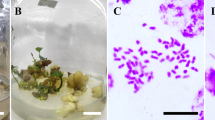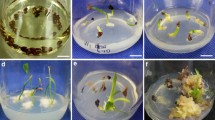Abstract
To screen a suitable method for inducing tetraploid with high frequency, five diploid inbred lines of watermelon, WC-8C-2C, WD-2-6K, GW11, GW7, and GW2 were selected. The efficiency of chromosome doubling with three methods direct seed (DS), shoot apex (SA), and inverted hypocotyl (IH) were tested by applying two different concentrations (0.1% and 0.2%) of antimitotic agent, colchicine, during the period January, 2010 to August, 2011 at Watermelon Experiment Station, Daesan, Gochang, Jeonbuk, South Korea. Mean chloroplast counts were 12 and 19 in diploid and tetraploid, respectively. The highest rate of efficiency of generating tetraploids (29.5%) was recorded in 0.2% IH method and considered as s best method. A total of 71 new tetraploids were generated successfully using present methods and techniques. WC-8C-2C and GW7 produced maximum number of tetraploids.
Similar content being viewed by others
Literature cited
Abak, K.C., N. Oèmlekciogælu, S. Buèyuèkalaca, and N. Sari. 1998. Use of stomatal characteristics to estimate ploidy level of haploid and dihaploid pepper plants. 10th EUCARPIA Mtg. Capsicum Eggplant, 7–11 September 1998, Avignon, France. p. 179–182.
Andrus, C.F., V.S. Seshadri, and P.C. Grimball. 1971. Production of seedless watermelons. ARS, U.S. Dept. Agric. Tech. Bull. p. 1425.
Barow, M. and A. Meister. 2003. Endopolyploidy in seed plants is differently correlated to systematics, organ, and life strategy and genome size. Plant Cell Environ. 26:571–584.
Brown, S.C., P. Devaux, D. Marie, C.V. Bergounioux, and P.X. Petit. 1991. Flow cytometry in vegetables for ploidy analysis. Biofuture 105:2–16. (in French)
Chopra, V.L. and M.S. Swaminathan. 1959. Induction of polyploidy in watermelon. Plant Sci. 51:57–65.
Compton, M.E. and D.J. Gray. 1993. Shoot Organogenesis and Plant Regeneration from Cotyledons of Diploid, Triploid, and Tetraploid Watermelon. J. Amer. Soc. Hort. Sci. 118:151–157.
Compton, M.E., B. Nancy, and D.J. Gray. 1999. Use of fluorescein diacetate (FDA) to determine ploidy in vitro watermelon shoots. Plant Cell Tiss. Organ Cult. 58:199–203.
Compton, M.E., D.J. Gray, and G.W. Elmstrom. 1993. A simple protocol for micro propagating diploid and tetraploid watermelon using shoot-tip explants. Plant Cell Tiss. Organ Cult. 33:211–217.
Compton, M.E., D.J. Gray, and G.W. Elmstrom. 1996. Identification of tetraploid regenerants from cotyledons of diploid watermelon cultured in vitro. Euphytica 87:165–172.
De Laat, A.M.M., W. Goèhde, and M.J.D.C. Vogelzang. 1987. Determination of ploidy of single plants and plants population by flow cytometry. Plant Breeding 99:303–307.
Doležel, J. and J. Bartoš. 2004. Plant DNA flow cytometry and estimation of nuclear genome size. Ann. Bot. 95:99–110.
Galbraith, D.W., K.R. Harkins, J.M. Maddox, N.M. Ayres, D.P. Sharma, and E. Firoozabady. 1983. Rapid flow cytometric analysis of the cell cycle in intact plant tissues. Science 220:1049–1051.
Hansen, N.J.P. and S.B. Andersen. 1996. In vitro chromosome doubling potential of colchicine, oryzalin, trifluralin, and APM in Brassica napus microspore culture. Euphytica 88:159–164.
Hülgenhof, E., R.A. Weidhase, R. Schlegel, and A. Tewes. 1988. Flow cytometric determination of DNA content in isolated nuclei of cereals. Genome 30:565–569.
Jaskani, M.J., Khan, I.A., M.M. Khan, and H. Abbas. 2007. Frequency of triploids in different interploidal crosses of citrus. Pak. J. Bot. 39:1517–1522.
Jaskani, M.J., S.W. Kwon, and D.H. Kim. 2005. Flow cytometry of DNA content of colchicine treated with watermelon as a ploidy screening method at M1 stage. Pak. J. Bot. 37:685–696.
Jaskani, M.J., S.W. Kwon, D.H. Kim, and A. Haider. 2006. Seed treatment and orientation affects germination and seedling emergency in tetraploid watermelon. Pak. J. Bot. 38:89–98.
Jaskani, M.J., S.W. Kwon, G.C. Koh, Y.C. Huh, and B.R. Ko. 2004a. Induction and characterization of tetraploid watermelon. J. Kor. Soc. Hort. Sci. 45:60–65.
Jaskani, M.J., S.W. Kwon, G.C. Koh, E.U. Kim, and B.R. Ko. 2004b. Polyploidy affects fruit characteristics, seed morphology, and germination in watermelon (Citrullus lanatus). J. Kor. Soc. Hort. Sci. 45:233–237.
Kamentsky, L.A., M.R. Melamed, and H. Derman. 1965. Spectrophotometer: New instrument for ultrarapid cell analysis. Science 150:630–631.
Kihara, H. 1951. Triploid watermelons. Proc. Amer. Soc. Hort. Sci. 58:217–230.
Koh, G.C. 2002. Tetraploid production of Moodeungsan watermelon. J. Kor. Soc. Hort. Sci. 43:671–676.
Koh, G.C. 2004. Characteristics of triploid seedless ‘Mudeungsan’ watermelon (Citrullus vulgaris) compared to its diploid and tetraploid counterparts. J. Kor. Soc. Hort. Sci. 45:293–298.
Lower, R.L. and K.W. Johnson. 1969. Observation on sterility of induced autotriploid watermelon. J. Amer. Soc. Hort. Sci. 94:367–369.
Marr, C.W. and K.L.B Gast. 1991. Reactions by consumers in a ‘farmers’ market to prices for seedless watermelon and ratings of eating quality. Hort. Tech. 1:105–106.
Matzk, F., A. Meister, and I. Schubert. 2000. An efficient screen for reproduction pathways using mature seeds of monocot and dicots. Plant J. 21:97–108.
McCuistion, G. and G.W. Elmstrom. 1993. Identifying polyploids of various cucurbits. Proc. Fla. State Hort. Soc. 106:155–157.
Omidbaigi, R., M. Mirzaee, M.E. Hassani, and M.S. Moghadam. 2010. Induction and Identification of polyploidy in basil (Ocimum basilicum L.) medicinal plants by colchicine treatment. Int. J. Plant Prod. 4:87–88.
Omran, S.A., J.M. Guerra-Sanz, and J.A. Garrido Cardenas. 2008. Methodology of tetraploid induction and expression of microsattelite alleles in triploid watermelon. Proc IX EUCARPIA Mtg. Genetics Breeding Cucurbiraceae. INRA, Avignon, France, 21–24 May. Omran, S.A. 2003.
Tetraploid watermelon induction and production of F1 hybrid seeds. Ph.D. Thesis, Tanta University, Egypt.
Pitchaimuthu, M., O.P. Dutta, V.S.R. Krishna Prasad, and K.R.M. Swamy. 2009. Development and evaluation of triploid seedless watermelon in India. 4th Intl. Cucurbitaceous Symp. p. 82–83. http://hdl.handle.net/123456789/218.
Puite, K.J. and W.R.R. Ten Broeke. 1983. DNA staining of fixed and non-fixed plant protoplasts for flow cytometry with Hoechst 33342. Plant Sci. Lett. 32:79–88.
Rode, J.C. and R. Dumas de Vaulx. 1987. Obtaining haploid plants in carrot (Daucus carota L.) from induced parthogenesis in situ by pollen irradiation and in vitro immature seed culture. Rept. Acad. Sci. Paris, Ser. III. 305:225–229. (in French)
Roux, N., A. Toloza, Z. Radecki, F.J. Zapata-Arias, and J. Doležel. 2003. Rapid detection of aneuploidy in Musa using flow cytometry. Plant Cell Rep. 21:483–490.
Roux, N., J. Doležel, R. Swennen, and F.J. Zapata-Arias. 2001. Effectiveness of three micropropagation techniques to dissociate cytochimeras in Musa spp. Plant Cell Tiss. Organ Cult. 66:189–197.
Sandoval, A., V. Hocker, and J.L. Verdeil. 2003. Flow cytometric analysis of the cell cycle in different coconut palm (Cocos nucifera L.) tissues cultured in vitro. Plant Cell Rep. 22:25–31.
Sari, N., K. Abak, and M. Pitrat. 1999. Comparison of ploidy level screening methods in watermelon: Citrullus lanatus (Thunb.) Matsum. and Nakai. Sci. Hortic. 2:265–277.
Suiyng, T., J.L. Xiuqiang, and L. Wenge. 1995. Raising the frequency of inducing tetraploid watermelon by treating colchicine. Acta Hort. 402:18–22.
Veilleux, R.E. and A.A.T. Johnson. 1998. Somaclonal variation: Molecular analysis, transformation and utilization, p. 229–268. In: J. Janick (ed.). Plant Breeding Reviews. John Willey & Sons Inc., New York.
Wehner, T.C. 2010. Watermelon crop information. Cucurbit breeding. NC State University. http://journal.ashspublications.org/cgi/content/abstract/ 118/1/151(2011).
Winarto, B., N.A. Mattjik, and J.A. Teixeira da Silva. 2010. Ploidy screening of anthurium (Anthurium andreanum Linden ex Andre) regenerants derived from anther culture. Sci. Hortic. 127:86–90.
Ye, Z., Y.Y. Wang, and H.Q. Tian. 2009. Regeneration of plantlets and tetraploidy induction in pseudostellaria heterophylla. Acta Biol. Cracov. Ser. Bot. 51:13–18.
Ying, L., J.F. Whitesides, and B. Rhodes. 1999. In vitro generation of tetraploid watermelon with two different dinitroanilines and colchicine. Cucurbit Genetic Coop. Rep. 22:38–40.
Zhang, X.P. 2003. Tetraploid watermelon producing small fruits. United States Patent Application Number 20030217395A1.
Zhang, X.P. 2007. Triploid hybrid watermelon. Proc. Amer. Soc. Hort. Sci. 58:217–230.
Zhang, X.P., B.B. Rhodes, H.T. Skorupska., and W.C. Bridges. 1995. Generating tetraploid watermelon using colchicine in vitro, p. 134–139. In: G. Lester and J.R. Dunlup (eds.). Proc. Cucurbitaceae 94 evaluation and enhancement of cucurbit germplasm. South Pedre Island, TX, USA.
Zhang, X.P., B.B. Rhodes, and J.W. Adelberg. 1994. Shoot regeneration from immature cotyledon of watermelon. Cucurbit Genetics Coop. Rep. 17:111–115.
Zhang, X.P. 2004. Inbred tetraploid watermelon line 90-4194. United States Patent Application Number 2004/0172690 A1.
Author information
Authors and Affiliations
Corresponding author
Rights and permissions
About this article
Cite this article
Noh, J., Sheikh, S., Chon, H.G. et al. Screening different methods of tetraploid induction in watermelon [Citrullus lanatus (thunb.) Manst. and Nakai]. Hortic. Environ. Biotechnol. 53, 521–529 (2012). https://doi.org/10.1007/s13580-012-0055-x
Received:
Revised:
Accepted:
Published:
Issue Date:
DOI: https://doi.org/10.1007/s13580-012-0055-x




